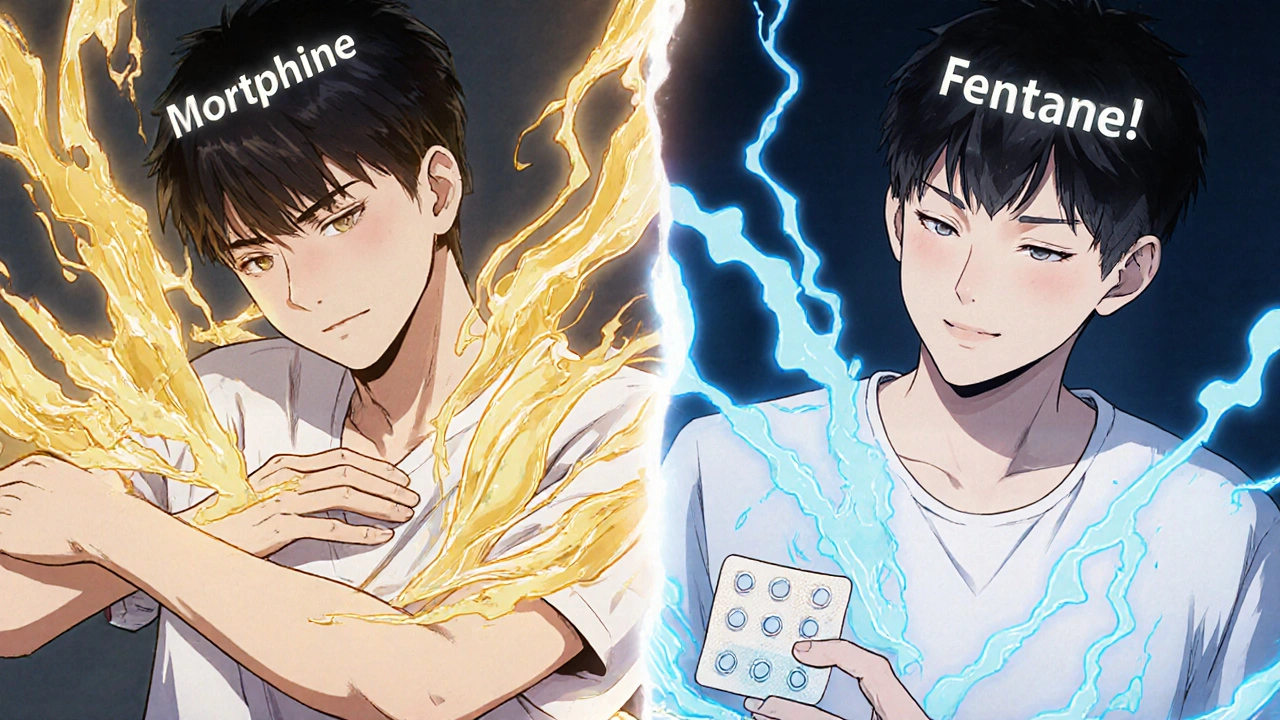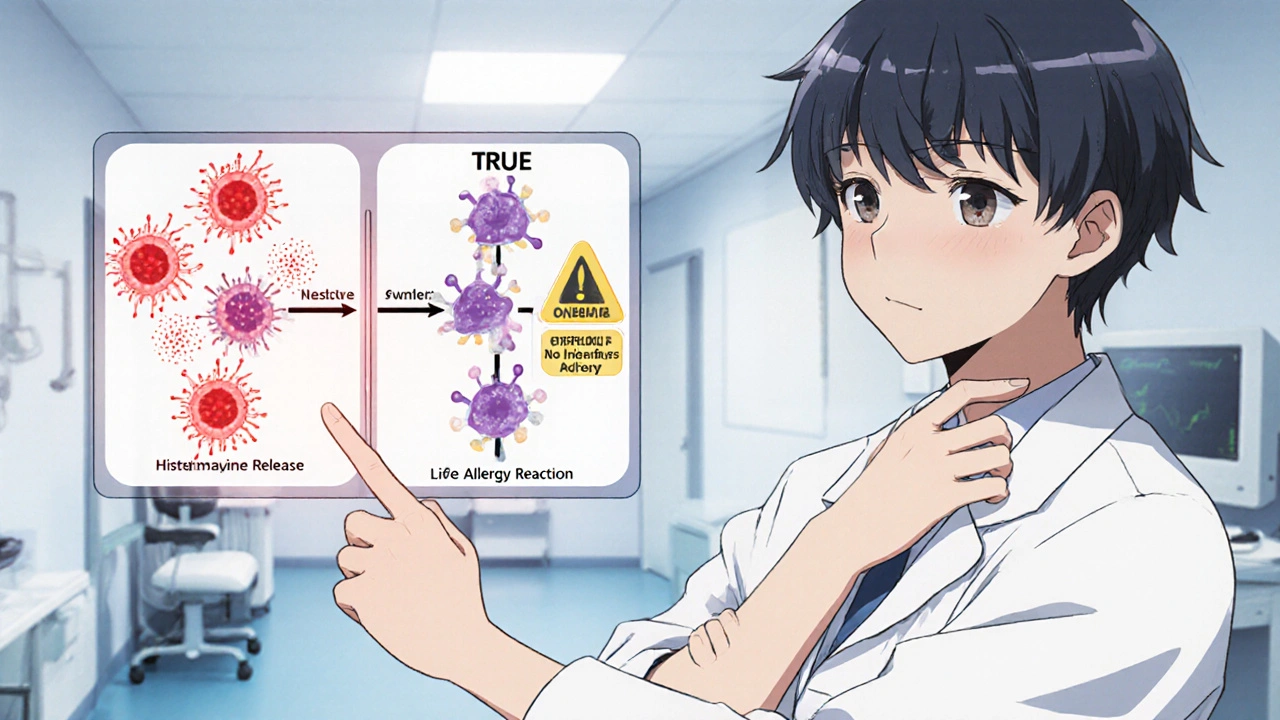Itching after taking an opioid isn’t rare - it’s common. But that doesn’t mean you’re allergic. In fact, most people who say they’re allergic to opioids aren’t. They’re just experiencing a side effect that looks like an allergy but works completely differently. This misunderstanding leads to unnecessary pain, skipped treatments, and higher costs. If you’ve ever felt itchy after morphine or oxycodone and were told to avoid all opioids, you might have been misinformed. Here’s how to tell real allergies from fake ones - and what to actually do about it.
Itching Isn’t an Allergy - Most of the Time
When you get itchy after an opioid like morphine, it’s usually not your immune system going haywire. It’s your mast cells releasing histamine directly. No antibodies. No T-cells. Just a chemical reaction triggered by the drug itself. This is called a pseudoallergic reaction. It happens in 70-80% of cases where people claim an opioid allergy. The itching isn’t dangerous - it’s annoying. And it’s dose-dependent. The more morphine you get, the worse it gets. Switch to fentanyl or methadone? The itching often disappears.
True opioid allergies? They’re rare. Less than 0.3% of people who take opioids have a real IgE-mediated immune response. That means hives, swelling of the throat, trouble breathing, or a sudden drop in blood pressure. These reactions happen fast - within minutes. And they’re life-threatening. But if your only symptom is itching, especially if it shows up after a dose increase or IV push, it’s almost certainly not a true allergy.
How Opioids Differ in Their Side Effects
Not all opioids are created equal when it comes to itching. Morphine and codeine are the biggest offenders. Morphine releases 3-4 times more histamine than hydromorphone at the same pain-relieving dose. That’s why so many people report itching after morphine - it’s built into the chemistry. Fentanyl, on the other hand, barely triggers histamine release. Methadone? Even less. Both are often used as alternatives when itching becomes unbearable.
Here’s a simple breakdown:
- High histamine releasers: Morphine, codeine, meperidine - itching is common (30-40% of users)
- Low histamine releasers: Fentanyl, methadone, hydromorphone - itching is rare (5-15% of users)
Why does this matter? Because if you’ve been told you’re allergic to all opioids because you got itchy on morphine, you’re being denied better options. Fentanyl patches or methadone could give you the same pain control without the itch. And you don’t need to suffer through it.
The Spinal Cord Connection: Why Itching Feels So Strong
Here’s something surprising: some opioid-induced itching doesn’t even involve histamine. Research from Washington University in 2007 found that opioids activate a specific receptor in the spinal cord called GRPR - gastrin-releasing peptide receptor. This triggers the itch signal directly to the brain, bypassing the skin entirely. That’s why antihistamines like Benadryl sometimes don’t help. The itch isn’t coming from your skin - it’s coming from your nerves.
This explains why some patients still itch even after taking antihistamines. It also explains why newer drugs like nalfurafine (approved in Japan, now in U.S. trials) work so well. Nalfurafine blocks the GRPR pathway. It reduces itching by 70% without dulling pain relief. It’s not available everywhere yet, but it’s a sign of where treatment is headed.
What to Do When You Get Itchy
If you’re itching after an opioid, don’t panic. Don’t assume you’re allergic. Don’t refuse pain meds. Do this instead:
- Check the dose. Was it a high dose? Was it given quickly? Pseudoallergic reactions are often worse with rapid IV pushes or high doses.
- Try a lower dose. Reduce the opioid by 25-50%. Many patients find the itching disappears at a lower dose.
- Take an antihistamine. Diphenhydramine (Benadryl) 25-50 mg IV or oral 30 minutes before the next dose helps in 80-90% of cases.
- Switch opioids. If itching continues, talk to your provider about switching to fentanyl, methadone, or hydromorphone. These rarely cause itching.
Don’t stop your pain medication unless you have signs of a real allergic reaction: swelling of the lips or tongue, wheezing, dizziness, or low blood pressure. Those need immediate medical attention.

When It’s a Real Allergy - And What to Do
True opioid allergies are rare, but they’re serious. Signs include:
- Hives or widespread rash
- Angioedema (deep swelling under the skin)
- Wheezing or trouble breathing
- Drop in blood pressure
- Feeling faint or passing out
If you’ve had any of these - especially within minutes of taking the drug - you likely have a true allergy. Avoid that opioid and any structurally similar ones (like oxycodone or hydrocodone). But you don’t need to avoid all opioids. Fentanyl and methadone rarely cross-react. Studies show less than 5% of people with a true morphine allergy react to fentanyl.
For patients who absolutely need the opioid they’re allergic to - like someone with cancer pain who only responds to morphine - desensitization is possible. A controlled, step-by-step IV infusion over 4-6 hours can train the body to tolerate it. Success rates are above 95% when done properly.
Why Mislabeling Costs You - And the System
Every time someone is incorrectly labeled allergic to opioids, the healthcare system pays more. Why? Because doctors turn to more expensive, less effective, or riskier alternatives. A 2020 JAMA study found mislabeled opioid allergies cost $1,200 per patient in extra medication and testing. Multiply that by 20-30 million people in the U.S. who report opioid allergies - and you’re looking at $24-36 billion wasted every year.
But the real cost is to you. You might be stuck with weaker pain control. You might avoid needed surgery because you’re labeled allergic. You might be denied cancer treatment because your pain can’t be managed. And you might be taking multiple drugs with more side effects than the opioid you’re avoiding.
What Patients Are Saying
On Reddit’s r/painmanagement, users share stories like:
“I was told I’m allergic to all opioids because I got itchy on morphine. Then I tried a fentanyl patch with Benadryl - no itching, no problem. Why did it take three years to figure this out?” - u/PainWarrior2022
Meanwhile, real allergic reactions are terrifying. One Mayo Clinic case report described a woman who went into anaphylaxis five minutes after her first morphine dose - blood pressure dropped to 70, oxygen saturation fell to 88%. She needed epinephrine and ICU care. That’s a true allergy. But it’s not the same as itching.

What Your Doctor Should Be Doing
Good providers now use simple tools to tell the difference. The Opioid Allergy Assessment Tool, developed at MD Anderson, asks three questions:
- Was the reaction isolated to itching or flushing?
- Did it happen with higher doses or rapid infusions?
- Did antihistamines help?
If the answer is yes to all three, it’s almost certainly a pseudoallergy. In studies, this tool correctly identifies 92% of cases.
And here’s the kicker: skin testing for opioid allergies is controversial. Some studies say it’s useful. Others say it gives false positives in 30% of cases. The American Pain Society doesn’t recommend routine skin testing unless someone had anaphylaxis. Instead, they suggest a supervised trial with a different opioid.
What You Can Do Today
If you’ve been told you’re allergic to opioids:
- Write down exactly what happened. Was it itching? When? After which dose?
- Check your medical records. Does it say “opioid allergy” - or “itching after morphine”?
- Ask your doctor: “Could this be a pseudoallergic reaction?”
- Request a trial with fentanyl or methadone, with antihistamines if needed.
- Don’t let a label stop you from getting proper pain relief.
If you’re a provider: stop writing “opioid allergy” unless it’s a true immune reaction. Use “histamine-mediated reaction” or “opioid-induced pruritus” instead. It changes how future providers think - and treat.
The Future Is Here
Researchers are working on opioids that don’t cause itching at all. Two drugs - CR845 and NOP receptor agonists - are in late-stage trials and cut pruritus by 80%. Genetic tests are also being developed to predict who’s more likely to have severe itching based on their HTR7 gene. And Stanford is testing a point-of-care blood test that can tell histamine release from true allergy in minutes.
But none of that matters if we don’t fix the biggest problem: misunderstanding. Opioid-induced itching is not an allergy. It’s a side effect. And side effects can be managed. Allergies need to be avoided. Don’t let a label rob you of pain relief.
Is itching after morphine a sign of an opioid allergy?
No, itching after morphine is almost never a true allergy. It’s a pseudoallergic reaction caused by histamine release from mast cells. True opioid allergies involve swelling, trouble breathing, or low blood pressure. Itching alone is a common side effect - not an allergy.
Can I still take opioids if I get itchy?
Yes. Many people who get itchy on morphine tolerate fentanyl, methadone, or hydromorphone just fine. Reducing the dose by 25-50% or taking diphenhydramine 30 minutes before the opioid often stops the itching. Switching opioids is a safe and effective solution.
Are all opioids equally likely to cause itching?
No. Morphine and codeine are high histamine releasers - itching is common. Fentanyl, methadone, and hydromorphone release far less histamine. Fentanyl causes itching in only 5-10% of users, compared to 30-40% with morphine. Your choice of opioid matters.
Should I get tested for an opioid allergy?
Only if you had a severe reaction like anaphylaxis (swelling, breathing trouble, fainting). Skin tests for opioids are unreliable and often give false positives. For itching alone, a supervised trial with a different opioid is safer and more accurate than testing.
What’s the best alternative to morphine if I get itchy?
Fentanyl patches or methadone are the best alternatives. Both cause significantly less histamine release. Fentanyl is ideal for moderate to severe pain with fewer side effects. Methadone works well for chronic pain but needs careful dosing due to its long half-life. Always start low and go slow.
Can I use Benadryl to stop opioid-induced itching?
Yes - and it works for most people. Diphenhydramine (Benadryl) 25-50 mg taken 30 minutes before the opioid reduces itching in 80-90% of cases. But if itching persists despite antihistamines, the cause may be spinal (GRPR pathway), and switching opioids is the next step.
Will I outgrow an opioid allergy?
True opioid allergies don’t go away - they’re immune-based. But most people labeled allergic aren’t truly allergic. If you only had itching, you likely never had an allergy to begin with. A supervised trial with another opioid can prove this safely.
Why do some doctors still say I’m allergic to all opioids?
Many providers weren’t trained to distinguish pseudoallergies from true allergies. Itching is common, and it’s easier to say “avoid all opioids” than to explain the difference. But guidelines from the American Academy of Allergy and the Mayo Clinic now clearly state that isolated itching is not an allergy. Ask for updated guidelines or a referral to an allergist if needed.

